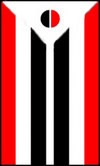Lesson Three - Part One
Intransitive Verbs
Arapaho makes a distinction in its verbs between actions and descriptions of animate and inanimate things. Here we will use the same verbs as in the previous section, but in order to talk about inanimate (non-living) things. The distinction between animate and inanimate will be discussed in full in Lesson Six.
Arapaho has four different types of verbs: intransitive verbs about animate things (VAI), intransitive verbs about inanimate things (VII), transitive verbs about animate objects (VTA), and transitive verbs about inanimate objects (VTI). So far, we are only looking at the two types of intransitive verbs.
Meanwhile, you can say the following in Arapaho:
|
|
It is yellow |
|
|
It is red |
|
|
It is clean |
|
|
It is strong |
The endings are normally one of the two following:
| Singular | Plural |
| -óó' | -óu'u |
| -éé' | -éí'i |
The choice of the ending depends on other vowels in the word. So, if the vowels are e and i, the endings -éé' and -éí'i are used. But if the vowels are a, o or u, the endings-óó' and -óú'u are used.
Note that the actual ending that means "it is" is simply the final -', which is a glottal stop, but the preceding vowels are given above since they change in a regular way with the plural.
So in order to say "they are yellow," Arapahos say nííhooyóu'u.
To say "they are red" is bee'éí'i.
Animate (VAI) versus Inanimate (VII) Subjects
The following examples show that there is a basic pattern between AI and II verbs:
|
|
I am yellow |
It is yellow |
|
| I am red
|
|
It is red |
|
I am black |
|
It is black |
|
| I am good
|
|
| It is good
|

